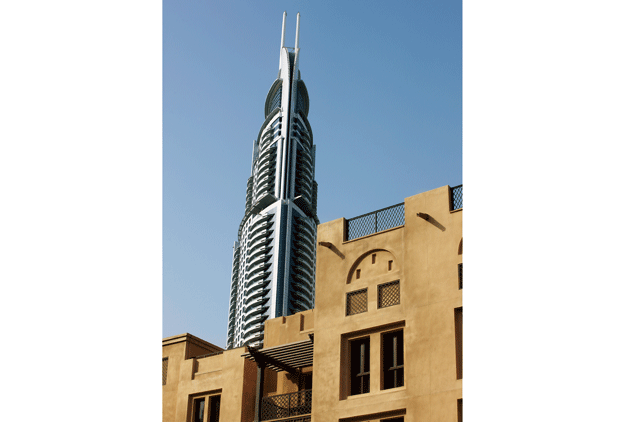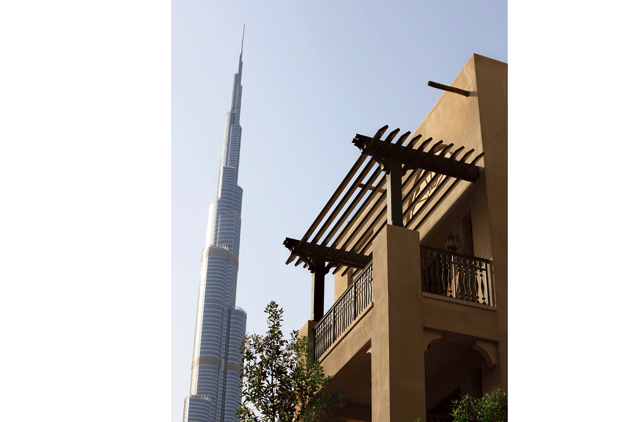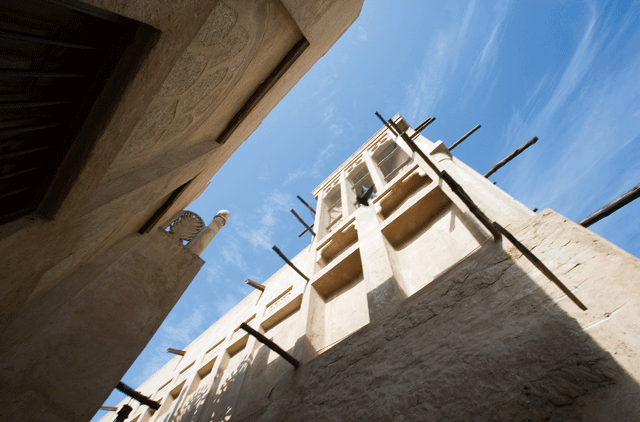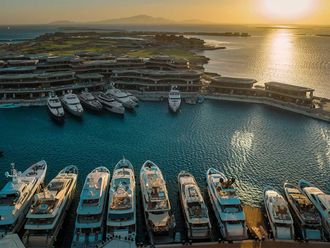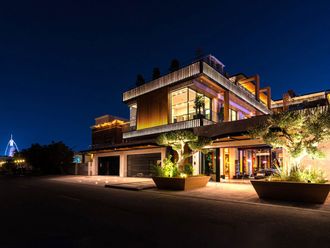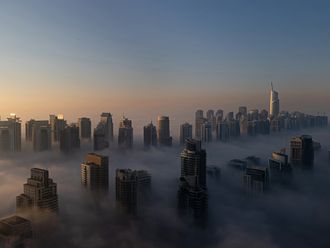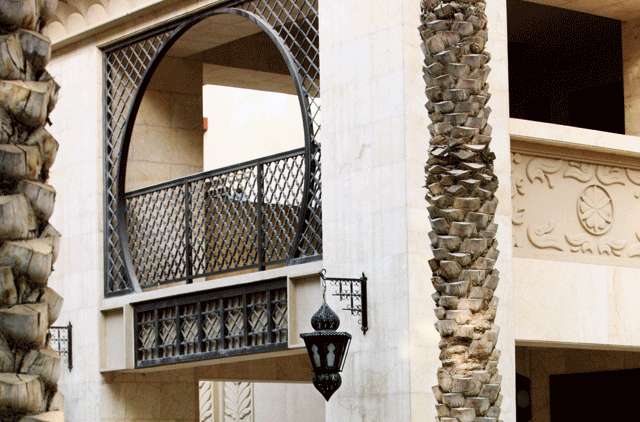
Once upon a time, in the late 1800s, the UAE was simply scattered with courtyard houses built from coral stone and gypsum - a testament to Arabian architecture. Then at the turn of the century, one fairytale ended as another began: the city expanded, the population increased, and Dubai experienced a construction boom. Today any remaining buildings are - quite literally - overshadowed by modern, skyscrapers and low-rise, gated communities. But, is there even a glimpse of Arabic tradition in Dubai's new landscape?
To answer this we have to understand what actually defines Arabian architecture. Who better to sum this up than Graeme Fisher, partner at Godwin Austen Johnson (GAJ) architectural firm, which is best known in Dubai for its Arabic-led designs at The One & Only Royal Mirage and Bab Al Shams.
Fisher sums up Arabic architecture saying: "Historically, Arabian architecture was approached from a very pragmatic standpoint. It was largely influenced by the climatic conditions of the desert, conservation of the environment and the wise use of resources. Cultural and religious values have also been major influences with a focus given to family cohesion, consideration of neighbours and limited ostentation.
"There are several design features that, we can say, define Arabian architecture - all of which help to keep buildings cool and protected from the harsh desert environment. In traditional Arabian designs, buildings are typically built close together to create shading over the narrow paths that separate them. These winding alleys also enable wind to increase in speed as it passes through, creating a natural form of air-conditioning."
Traditional buildings were built with thick walls and small windows to insulate them from extreme heat and cold, and their wind towers are a unique architectural feature that allows trapped air to be directed to the rooms beneath.
"Another common feature is the central courtyard, usually with a pool or water feature called a ‘howz'. Rooms front onto the courtyard, framed by shaded verandas, allowing hot air to escape, and the water also enables cooler air to circulate through the process of evaporation," adds Fisher. While the decorative detail of Chinese architecture or the gothic style of Victorian England lives on in their home countries, the Arabic architectural style has been diluted, in some parts of the UAE and certainly Dubai.
Modern influence
Fisher explains, "Over the last 20 years, the UAE has experienced rapid urbanisation and that has brought with it modern architectural and building techniques, with a focus on speed of construction. Dubai and Abu Dhabi in particular have visions of being modern world cities and first class tourist destinations, so contemporary designs have featured prominently."
While they may be few and far between, you will find examples of traditional Arabian architecture across the UAE - homes in less developed emirates such as Umm Al Quwain, mosques such as Jumeirah Mosque, and souqs such as the Gold Souq in Bur Dubai.
One of the most striking examples in Dubai is the Al Bastakiya area, in the eastern section of the old town along the Creek in Bur Dubai. Dating back to the early 1900s, Al Bastakiya's narrow pathways, courtyards, thick-walled buildings and small windows all help to keep the area cool and shaded.
Fareed Esmail, founding partner, X-Architects, is sympathetic to Arabic architecture. "This old area of Dubai is a very good example of Arabian architecture because it shows how people used to deal with the environment. We don't have to copy this style, but we can definitely learn from it.
"That is what we have done at the Al Naseem development in Al Ain, which responds to the cultural and social environment. We're also designing villas in the UAE for young Emiratis - who want to live in a more contemporary way and keep the social values of being an Emirati - with a separate majlis for men and women, openness within the house, as well as private zones."
For the most part, new developments in Dubai, blend the traditional with the contemporary, ensuring that the UAE holds onto its national identity while becoming internationally renowned for its visionary architecture.
Fisher says, "As architects we have a responsibility to design with contextual relevance. We should be able, through design, to harness and celebrate local and cultural identity. In a place such as the UAE where we see a myriad of nationalities and cultures living and working together, it is vital that the country does not lose its own national identity. Architects and designers have a responsibility to contribute towards this.
"The marriage of contemporary design with strong Arabic influences can be incredibly seductive. Our work at GAJ ranges from a language, which is extremely modern with a touch of Arabic influence, through to a more Arabic expression with touches of modern and contemporary aspects. The important thing for us is to avoid is the pastiche."
Dubai landmarks such as the Burj Khalifa make
a spectacular creative nod to tradition, with a design derived from the patterns embodied in Islamic architecture and the triple-lobed footprint of the building based on an abstracted version of a native desert flower. Other Arabic-inspired buildings include Bab Al Shams and The One & Only Royal Mirage, both designed by GAJ.
At Bab Al Shams, courtyards, narrow streets and alleyways, covered passages and falajs (water canals) provide the ambience and atmosphere of a traditional village in the desert, and streets and courtyards are designed as part of the rooms and interior spaces.
Fisher explains, "The development is a compact entity sitting within the vast openness of the environment, a secluded, safe retreat from both the heat and cold of the surrounding desert. Ornamentation has been kept to a minimum and thick walls and relatively small openings help with the thermal efficiency of the design, as do the narrow streets and alleys which run between the two storey buildings, ensuring maximum overshadowing."
Similarly, the Arabian Court at The One & Only Royal Mirage is also inspired by aspects of Arabian architecture. Fisher says, "The concept behind this project was to try to design the "undesignable", and to recreate that uniquely random and natural growth that sets apart the normal definition of architecture. What you get is a sense of "architecture without architects" by incorporating a range of different spatial experiences in a way that most modern architectural planning seeks to regulate, or worse, avoid by imposing an idea of a formal structure or logic.
"It was therefore necessary to avoid the more formal planning that, while present in Ottoman and Moghul architecture, is more often balanced by an organic approach in old Arab cities and indeed other old cities throughout the world."
But while we can choose to meander through the traditional streets of Al Bastakiya or sample the culture while on holiday at Bab Al Shams, do Dubai residents really want to live in Arabic-inspired buildings?
While there may not be any age-old communities that have stood the test of time, new developments such as Al Barari, The Old Town and Al Furjan blend the old and the new to give a modern interpretation of Islamic architecture.
Blending the old and the new
Fisher says, "There is a wide range of buildings across the UAE which have, to a greater or lesser extent, this marriage of the two forms - and some are clearly more successful than others."
At Al Barari, Islamic influences are felt in the spacious villas, which are a throwback to Arabian luxury with an emphasis on privacy, landscaped gardens and vast courtyards. The Old Town celebrates classical Arabian architecture with its traditionally-styled homes and use of Arabic design elements in its period furniture and fittings, ornate carved doors, and traditional Arabic courtyards.
Al Furjan adopts the Arabian architectural style on a grand scale with a collection of homes designed as a single village, and it builds on this tradition to create a modern neighbourhood that celebrates traditional family living.
It's such architecture as seen in these three developments - which blends Arabia's traditional structural designs with modernity - that highlights the rapid growth of Dubai from a small fishing town to a prosperous UAE city. But, while some may regard this as their dream Arabian home, is it all too good to be true?
Esmail says, "I see The Old Town as a cliché, a copy and paste of Arabian architecture, that is just redoing what people have done before but not necessarily doing it sensitively in regards to the environment or cultural issues. Consequently, I think it becomes just like any other complex or apartment.
"People are not looking for a copy and paste Arabic style. They want us to learn from the principles of tradition and present it as more contemporary."
But Jill Masters, an Old Town resident, says: "I think it's authentic but with a modern twist. The colours and materials give it an authentic and traditional feel, but with modern living in mind. The low-rise nature of the development gives it a genuine community feel which I also think lends to its Arabian style. And, the little touches in the entrance lobby such as the Arabic style lighting, decorations and seating area really add to the traditional style and atmosphere."
It's a matter of personal taste at the end of the day - but for now Arabic architecture and tradition lives on in the bricks and mortar of Dubai.
TYPICAL DESIGN FEATURES
- Buildings are built close together to create shading over the narrow paths that separate them.
- Winding alleys enable wind to increase in speed as it passes through, creating a natural form of air conditioning.
- Thick walls and small windows insulate buildings from extreme heat and cold.
- The central courtyard, usually with a pool or water feature.
- Wind tower allows trapped air to be directed to the rooms beneath.


